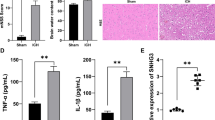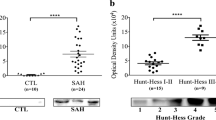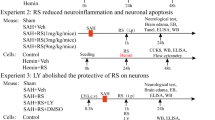Abstract
NLRP3 inflammasomes have been reported to be an essential mediator in the inflammatory response during early brain injury (EBI) following subarachnoid hemorrhage (SAH). Recent studies have indicated that NLRP3 inflammasome-mediated pyroptosis and long non-coding RNA (lncRNA) H19 can participate in the inflammatory response. However, the roles and functions of lncRNA H19 in NLRP3 inflammasome-mediated pyroptosis during EBI after SAH are unknown and need to be further elucidated. NLRP3 inflammasome proteins were significantly elevated in CSF of human with SAH induced EBI and presented a positive correlation with severity. In ipsilateral hemisphere cortex of rats, these NLRP3 inflammasome proteins were also increased and accompanied with upregulation of H19, and both of NLRP3 and H19 were peaked at 24 h after SAH. However, knockdown of H19 markedly decreased the expression of NLRP3 inflammasome proteins at 24 h after SAH in rats and also ameliorated EBI, showing improved neurobehavioral deficits, cerebral edema, and neuronal injury. Moreover, knocking down of H19 downregulated the expression of Gasdermin D (GSDMD) in microglia in SAH rats. Similarly, knockdown of H19 also alleviated OxyHb-induced pyroptosis and NLRP3-mediated inflammasomes activation in primary microglia. Lastly, H19 competitively sponged with rno-miR-138-5p and then upregulated NLRP3 expression in the post-SAH inflammatory response. lncRNA H19 promotes NLRP3-mediated pyroptosis by functioning as rno-miR-138-5p sponge in rats during EBI after SAH, which might provide a potential therapeutic target for post-SAH inflammation regulation.







Similar content being viewed by others
Data Availability
Not applicable.
Abbreviations
- NLRP3 :
-
Nucleotide-binding oligomerization domain, leucine rich repeat and pyrin domain containing 3
- EBI :
-
Early brain injury
- SAH :
-
Subarachnoid hemorrhage
- lncRNAs :
-
Long non-coding RNAs
- CSF :
-
Cerebrospinal fluid
- IL :
-
Interleukin
- ICV :
-
Intracerebroventricular
- AAV :
-
Adeno-associated virus
- OxyHb :
-
Oxyhemoglobin
- GSDMD :
-
Gasdermin D
- ceRNAs :
-
Competitive endogenous RNAs
- CT :
-
Computed tomography
- DSA :
-
Digital subtraction angiography
- mFS :
-
Modified Fisher scale
- LD :
-
Lumbar drainage
- EVD :
-
External ventricular drainage
- CNS :
-
Central nervous system
- BMI :
-
Body mass index
- KD :
-
Knock down
- CON :
-
Control
- PCD :
-
Programmed cell death
- FL :
-
Full length
References
Sangeetha RP, Venkatapura RJ, Kamath S, Christopher R, Bhat DI, Arvinda HR, et al. Effect of remote ischemic preconditioning on cerebral vasospasm, biomarkers of cerebral ischemia, and functional outcomes in aneurysmal subarachnoid hemorrhage (ERVAS): a randomized controlled pilot trial. Brain Circ. 2021;7(2):104–10. https://doi.org/10.4103/bc.bc_13_21.
Macdonald RL, Schweizer TA. Spontaneous subarachnoid haemorrhage. Lancet. 2017;389(10069):655–66. https://doi.org/10.1016/S0140-6736(16)30668-7.
Majewska P, Hara S, Gulati S, Solheim O. Association between transcranial Doppler vasospasm and functional outcome after subarachnoid hemorrhage. Brain Circ. 2021;7(4):271–6. https://doi.org/10.4103/bc.bc_63_21.
Chen S, Feng H, Sherchan P, Klebe D, Zhao G, Sun X, et al. Controversies and evolving new mechanisms in subarachnoid hemorrhage. Prog Neurobiol. 2014;115:64–91. https://doi.org/10.1016/j.pneurobio.2013.09.002.
Suzuki H. What is early brain injury? Transl Stroke Res. 2015;6(1):1–3. https://doi.org/10.1007/s12975-014-0380-8.
Strowig T, Henao-Mejia J, Elinav E, Flavell R. Inflammasomes in health and disease. Nature. 2012;481(7381):278–86. https://doi.org/10.1038/nature10759.
Jia Y, Cui R, Wang C, Feng Y, Li Z, Tong Y, et al. Metformin protects against intestinal ischemia-reperfusion injury and cell pyroptosis via TXNIP-NLRP3-GSDMD pathway. Redox Biol. 2020;32:101534. https://doi.org/10.1016/j.redox.2020.101534.
Orning P, Lien E, Fitzgerald KA. Gasdermins and their role in immunity and inflammation. J Exp Med. 2019;216(11):2453–65. https://doi.org/10.1084/jem.20190545.
Chen S, Ma Q, Krafft PR, Hu Q, Rolland W 2nd, Sherchan P, et al. P2X7R/cryopyrin inflammasome axis inhibition reduces neuroinflammation after SAH. Neurobiol Dis. 2013;58:296–307. https://doi.org/10.1016/j.nbd.2013.06.011.
Ma Q, Chen S, Hu Q, Feng H, Zhang JH, Tang J. NLRP3 inflammasome contributes to inflammation after intracerebral hemorrhage. Ann Neurol. 2014;75(2):209–19. https://doi.org/10.1002/ana.24070.
Luo Y, Lu J, Ruan W, Guo X, Chen S. MCC950 attenuated early brain injury by suppressing NLRP3 inflammasome after experimental SAH in rats. Brain Res Bull. 2019;146:320–6. https://doi.org/10.1016/j.brainresbull.2019.01.027.
Kopp F, Mendell JT. Functional classification and experimental dissection of long noncoding RNAs. Cell. 2018;172(3):393–407. https://doi.org/10.1016/j.cell.2018.01.011.
Liang Z, Chi YJ, Lin GQ, Xiao LF, Su GL, Yang LM. lncRNA MEG3 participates in neuronal cell injury induced by subarachnoid hemorrhage via inhibiting the Pi3k/Akt pathway. Eur Rev Med Pharmacol Sci. 2018;22(9):2824–31. https://doi.org/10.26355/eurrev_201805_14983.
Peng J, Wu Y, Tian X, Pang J, Kuai L, Cao F, et al. High-throughput sequencing and co-expression network analysis of lncRNAs and mRNAs in early brain injury following experimental subarachnoid haemorrhage. Sci Rep. 2017;7:46577. https://doi.org/10.1038/srep46577.
Chen JX, Wang YP, Zhang X, Li GX, Zheng K, Duan CZ. lncRNA Mtss1 promotes inflammatory responses and secondary brain injury after intracerebral hemorrhage by targeting miR-709 in mice. Brain Res Bull. 2020;162:20–9. https://doi.org/10.1016/j.brainresbull.2020.04.017.
Wang H, Liao S, Li H, Chen Y, Yu J. Long non-coding RNA TUG1 sponges mir-145a-5p to regulate microglial polarization after oxygen-glucose deprivation. Front Mol Neurosci. 2019;12:215. https://doi.org/10.3389/fnmol.2019.00215.
Ge Y, Lin D, Cui B, Zhang L, Li S, Wang Z, et al. Effects of long noncoding RNA H19 on isoflurane-induced cognitive dysregulation by promoting neuroinflammation. Neuroimmunomodulation. 2021:1–11; https://doi.org/10.1159/000519124.
Wang J, Zhao H, Fan Z, Li G, Ma Q, Tao Z, et al. Long noncoding RNA H19 promotes neuroinflammation in ischemic stroke by driving histone deacetylase 1-dependent M1 microglial polarization. Stroke. 2017;48(8):2211–21. https://doi.org/10.1161/STROKEAHA.117.017387.
Han CL, Ge M, Liu YP, Zhao XM, Wang KL, Chen N, et al. Long non-coding RNA H19 contributes to apoptosis of hippocampal neurons by inhibiting let-7b in a rat model of temporal lobe epilepsy. Cell Death Dis. 2018;9(6):617. https://doi.org/10.1038/s41419-018-0496-y.
Deng Y, Chen D, Gao F, Lv H, Zhang G, Sun X, et al. Exosomes derived from microRNA-138–5p-overexpressing bone marrow-derived mesenchymal stem cells confer neuroprotection to astrocytes following ischemic stroke via inhibition of LCN2. J Biol Eng. 2019;13:71. https://doi.org/10.1186/s13036-019-0193-0.
Sehba FA. Rat endovascular perforation model. Transl Stroke Res. 2014;5(6):660–8. https://doi.org/10.1007/s12975-014-0368-4.
Sugawara T, Ayer R, Jadhav V, Zhang JH. A new grading system evaluating bleeding scale in filament perforation subarachnoid hemorrhage rat model. J Neurosci Methods. 2008;167(2):327–34. https://doi.org/10.1016/j.jneumeth.2007.08.004.
Wang F, Teng Z, Liu D, Wang Y, Lou J, Dong Z. Beta-caryophyllene liposomes attenuate neurovascular unit damage after subarachnoid hemorrhage in rats. Neurochem Res. 2020;45(8):1758–68. https://doi.org/10.1007/s11064-020-03037-8.
Tamashiro TT, Dalgard CL, Byrnes KR. Primary microglia isolation from mixed glial cell cultures of neonatal rat brain tissue. J Vis Exp. 2012;66:e3814. https://doi.org/10.3791/3814.
Peng Y, Zhuang J, Ying G, Zeng H, Zhou H, Cao Y, et al. Stimulator of IFN genes mediates neuroinflammatory injury by suppressing AMPK signal in experimental subarachnoid hemorrhage. J Neuroinflammation. 2020;17(1):165. https://doi.org/10.1186/s12974-020-01830-4.
Xu P, Zhang X, Liu Q, Xie Y, Shi X, Chen J, et al. Microglial TREM-1 receptor mediates neuroinflammatory injury via interaction with SYK in experimental ischemic stroke. Cell Death Dis. 2019;10(8):555. https://doi.org/10.1038/s41419-019-1777-9.
Lee SW, de Rivero Vaccari JP, Truettner JS, Dietrich WD, Keane RW. The role of microglial inflammasome activation in pyroptotic cell death following penetrating traumatic brain injury. J Neuroinflammation. 2019;16(1):27. https://doi.org/10.1186/s12974-019-1423-6.
Zhao Y, Ai Y. Overexpression of lncRNA Gm15621 alleviates apoptosis and inflammation response resulting from sevoflurane treatment through inhibiting miR-133a/Sox4. J Cell Physiol. 2020;235(2):957–65. https://doi.org/10.1002/jcp.29011.
Tripathi S, Shree B, Mohapatra S, Swati Basu A, Sharma V. The expanding regulatory mechanisms and cellular functions of long non-coding RNAs (lncRNAs) in neuroinflammation. Mol Neurobiol. 2021;58(6):2916–39. https://doi.org/10.1007/s12035-020-02268-8.
Xu P, Tao C, Zhu Y, Wang G, Kong L, Li W, et al. TAK1 mediates neuronal pyroptosis in early brain injury after subarachnoid hemorrhage. J Neuroinflammation. 2021;18(1):188. https://doi.org/10.1186/s12974-021-02226-8.
Li Z, Han X. Resveratrol alleviates early brain injury following subarachnoid hemorrhage: possible involvement of the AMPK/SIRT1/autophagy signaling pathway. Biol Chem. 2018;399(11):1339–50. https://doi.org/10.1515/hsz-2018-0269.
Swanson KV, Deng M, Ting JP. The NLRP3 inflammasome: molecular activation and regulation to therapeutics. Nat Rev Immunol. 2019;19(8):477–89. https://doi.org/10.1038/s41577-019-0165-0.
Jorgensen I, Miao EA. Pyroptotic cell death defends against intracellular pathogens. Immunol Rev. 2015;265(1):130–42. https://doi.org/10.1111/imr.12287.
Shi J, Gao W, Shao F. Pyroptosis: gasdermin-mediated programmed necrotic cell death. Trends Biochem Sci. 2017;42(4):245–54. https://doi.org/10.1016/j.tibs.2016.10.004.
Xu S, Wang J, Zhong J, Shao M, Jiang J, Song J, et al. CD73 alleviates GSDMD-mediated microglia pyroptosis in spinal cord injury through PI3K/AKT/Foxo1 signaling. Clin Transl Med. 2021;11(1): e269. https://doi.org/10.1002/ctm2.269.
Li Q, Cao Y, Dang C, Han B, Han R, Ma H, et al. Inhibition of double-strand DNA-sensing cGAS ameliorates brain injury after ischemic stroke. EMBO Mol Med. 2020;12(4):11002. https://doi.org/10.15252/emmm.201911002.
Wang S, Liu Y, Zhang L, Sun Z. Methods for monitoring cancer cell pyroptosis. Cancer Biol Med. 2021; https://doi.org/10.20892/j.issn.2095-3941.2021.0504.
Gareev I, Beylerli O, Aliev G, Pavlov V, Izmailov A, Zhang Y, et al. The role of long non-coding RNAs in intracranial aneurysms and subarachnoid hemorrhage. Life (Basel). 2020;10(9); https://doi.org/10.3390/life10090155.
Marques-Rocha JL, Samblas M, Milagro FI, Bressan J, Martinez JA, Marti A. Noncoding RNAs, cytokines, and inflammation-related diseases. FASEB J. 2015;29(9):3595–611. https://doi.org/10.1096/fj.14-260323.
Acknowledgements
We are grateful to our researchers, collaborators, and technical assistants for their helpful suggestions and experimental assistance.
Funding
This study was supported by grants from National Natural Science Foundation of China (81870916) of Jianmin Zhang and National Natural Science Foundation of China (81971107) of Sheng Chen.
Author information
Authors and Affiliations
Contributions
Sheng Chen, Zhongzhou Su, and Yuanjian Fang contributed to the design of study. Yuanjian Fang, Xiaoyu Wang, and Zhoule Zhu performed the clinical sample collection and statistical analysis. Yibo Liu, Yujie Luo, Anke Zhang, Zefeng Wang, and Zeyu Zhang conducted the in vivo experiments. Yibo Liu, Qian Yu, and Kaikai Wang conducted the in vitro experiments. Yibo Liu, Luxi Chen, and Xiaohu Nie wrote the manuscript. John H. Zhang and Jianmin Zhang verified the underlying data. All authors read and approved the final version of the manuscript.
Corresponding authors
Ethics declarations
Competing interests
The authors declare no competing interests.
Ethics Approval and Consent to Participate
Not applicable.
Consent for Publication
Not applicable.
Conflict of Interest
The authors declare no competing interests.
Additional information
Publisher's Note
Springer Nature remains neutral with regard to jurisdictional claims in published maps and institutional affiliations.
Supplementary Information
Below is the link to the electronic supplementary material.
Rights and permissions
Springer Nature or its licensor (e.g. a society or other partner) holds exclusive rights to this article under a publishing agreement with the author(s) or other rightsholder(s); author self-archiving of the accepted manuscript version of this article is solely governed by the terms of such publishing agreement and applicable law.
About this article
Cite this article
Liu, Y., Luo, Y., Zhang, A. et al. Long Non-coding RNA H19 Promotes NLRP3-Mediated Pyroptosis After Subarachnoid Hemorrhage in Rats. Transl. Stroke Res. 14, 987–1001 (2023). https://doi.org/10.1007/s12975-022-01104-6
Received:
Revised:
Accepted:
Published:
Issue Date:
DOI: https://doi.org/10.1007/s12975-022-01104-6




